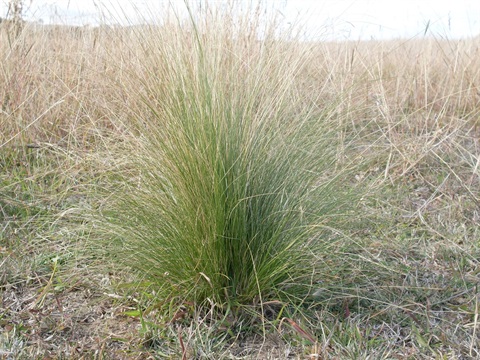
Welcome back to Council's Weed of the Week series for the 2023/24 spring and summer season. From September through February, we'll be sharing information and advice on new, emerging and established invasive plant species for the Snowy Monaro community.
Whether you're living on the land, living in town, or just passing through – we all have a part to play in protecting our natural environment and agricultural land from invasive plants and weeds.
Kicking off Weed of the Week for the season is a familiar foe, and one of the worst weeds in the Snowy Monaro – serrated tussock.
Serrated tussock is a perennial, drought resistant, tussock forming grass with a deep root system. Serrated tussock is a problem weed because it is extremely low in feed value and almost entirely indigestible to animals. This allows it to dominate native and introduced pastures where other grasses are preferentially grazed.
Serrated tussock plants seed prolifically, usually during late October and November. During this time they are most easily distinguished by their drooping, purple seedheads, which typically detach and disperse by Christmas time.
Seeds are easily dispersed by wind, water, animals, vehicles and fodder, which gives serrated tussock the ability to populate new and remote areas easily.
Due to its invasive impact on both agriculture and the environment, serrated tussock should be strategically targeted by public and private land managers to limit seeding and minimise spread.
Tips for managing Serrated Tussock:
- The number one rule: maintain strong, competitive pastures to prevent establishment of serrated tussock establishment. Disturbed ground = weeds.
- Plan to control all serrated tussock before it produces seeds. One year of seeding means many years of weeding.
- Decide what control methods are most appropriate to your situation:
- Manual removal or spot spraying is most effective for managing isolated or light infestations and minimises ground disturbance
- Boom spraying and long-term pasture renovation strategies are most effective at managing heavy infestations on arable land (giving consideration to the legal restrictions on clearing native vegetation and native grasslands)
- Non-chemical options include digging or chipping out the plants. You can scatter grass seed over larger bare areas to help stop weeds from growing.
- Consider whether you have the time, equipment and ability to do the work yourself. It might be more practical and efficient to engage a contractor to do the work on your behalf.
- Coordinate your weed control efforts with your neighbours. You may be able to share resources and achieve more effective results.
- Flupropanate and glyphosate are most commonly used for controlling grassy weeds like Serrated Tussock.
- From September onwards, a mixture of Flupropanate and Glyphosate will prevent seed set. Refer to Australian Pesticides and Veterinary Medicines Authority permit 9792.
- Use glyphosate on actively growing plants only. Glyphosate is absorbed through the leaves of plants and acts very quickly but is not selective and will kill most plants on contact.
- Flupropanate is a more selective, longer-acting herbicide that is absorbed mostly through the roots of plants. Flupropanate can take several months to kill grassy weeds and will remain active in the soil until about 100mL of leaching rain has moved it out of the plant's root zone.
- Ensure that you rotate herbicides regularly to reduce resistance issues. Consider using flupropanate through the winter months, mopping up remaining plants with glyphosate in the warmer months when plants are actively growing.
- After a long break in the supply of flupropanate, it is slowly but surely returning to local shelves. Flupropanate is a valuable tool that should be used carefully and integrated with other control techniques.
As with all weeds, prevention is the best control option. Maintaining a vigorous perennial ground cover at all times will inhibit the establishment of serrated tussock.






